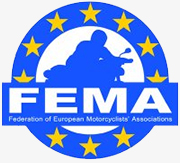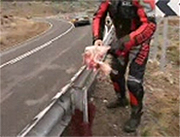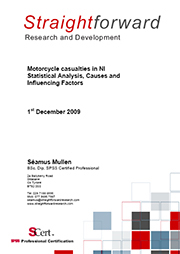 The Federation of European Motorcyclists Associations (FEMA) reports that Dutch MEPs Corien Wortmann-Kool and Wim van de Camp are backing FEMA’s pledge for political action to put an end to dangerous crash barriers.
The Federation of European Motorcyclists Associations (FEMA) reports that Dutch MEPs Corien Wortmann-Kool and Wim van de Camp are backing FEMA’s pledge for political action to put an end to dangerous crash barriers.
The two Members of the European Parliament have put their weight behind FEMA’s campaign, urging the European Commission to take action now.
FEMA say that, “After two decades of awareness campaigns and active national lobbying, products specifically dedicated to protecting sliding motorcyclists are now available on the market. However, the current European standard still does not include anything on motorcyclist protection. Some countries hide behind this and refuse to install more protective systems.”
CEN – the European Committee for Standardization, responsible for standards ranging from toys to fire extinguishers – is working on an improvement and produced an acceptable draft late last year.
At a Working Group meeting in Paris recently, FEMA reports that, represented by Juan Soroa, Vice President of the Spanish FEMA member Asociación Mutua Motera, a critical vote taken that approved a new draft standard for guardrails, partly prepared and strongly supported by FEMA.
The draft features the inclusion of motorcycle accidents into testing standards for road infrastructure.
The existing CEN standard leaves out motorcyclists, but an improved version could provide an acceptable level of safety for all road users.
 Before a final vote, which takes place in Prague the 24th and 25th June, the draft standard enters a polling phase where the different national committees have the opportunity to send technical comments.
Before a final vote, which takes place in Prague the 24th and 25th June, the draft standard enters a polling phase where the different national committees have the opportunity to send technical comments.
If comments are favourable, the draft will then be presented to the CEN Committee (TC226) for final voting in June. If the vote is carried, the draft will become standard EN 1317-8. It will then be transposed in every country within six months.
FEMA hopes that national committees will not cripple the draft with unnecessary comments, as last year, the proposed standard EN 1317-8 reached a similar stage but was eventually turned down before the final vote due to too many comments, delaying the process for a whole twelve months.
“We are at a very delicate stage now,” says Hugo Roebroeck, FEMA’s Campaigns Officer, “a similar draft was rejected in June last year because some CEN members wanted to tinker some more with it. We believe it’s not the good way to go: CEN should validate now an acceptable standard that protects riders, and then improve it later.
We have already lost a year and they can’t delay this forever, the motorcycling community won’t accept it.”
Three Members of the European Parliament, Corien Wortmann-Kool, Wim van der Camp and Bernd Lange, who have backed FEMA and have called for the European Commission to support the process.
The Commission has an advisory position at CEN, and could help greatly by supporting the process, as it did in the past on other topics.
“We are confident that more Members of the European Parliament will back us.”
Hugo Roebroeck, FEMA’s Campaigns Officer added. “Motorcyclists have worked hard for this.”
“It will be a test for the new college of Commissioners, to see if they are serious about their plans for improving road safety – for everyone.”
Original Source: www.fema-online.eu
Right To Ride Comments
We have watched with interest FEMAs progress, having a particular interest with our own issues regarding Barriers
Right To Rides Trevor Baird was part of a working group, when with the Motorcycle Action Group (MAG UK), along with Morten Hansen Norsk Motorcykkel Union (NMCU) – Norway, Wim Taal Motorcyclists’ Action Group (MAG) – The Netherlands who produced FEMAs 2005 “Road To Success – improving motorcyclists’ safety by improving crash barriers”
The Road to Success aimed to give an overview of the projects that have been successfully carried out in a number of European countries, it also described the difficulties and obstacles that motorcyclists’ organisations encounter.
The Road to Success complemented the 2000 FEMA the ‘Final report of the motorcyclists and crash barriers project’. This project aimed to develop recommendations to road authorities for reducing injuries to motorcyclists in collision with crash barriers. The project was supported by the Directorate General for Energy and Transport of the European Commission.
It also listed conclusions and recommendations to assist politicians, road authorities and motorcyclists’ organizations in order to implement successful policies with the aim of improving the safety of motorcyclists by improving crash barriers.
We congratulate FEMA on the work it has completed so far and hopefully the CEN standards is the final stretch on the Road to Success.
Existing Barrier Configurations – Northern Ireland Aspect
 The recent DOE Road Safety Strategy Consultation in Northern Ireland states that it will:
The recent DOE Road Safety Strategy Consultation in Northern Ireland states that it will:
- Consider provision of specific route treatments for popular motorcycle ‘runs’ such as motorcycle ‘friendly’ barriers and additional signing.
- Consider the needs and vulnerability of motorcyclists when designing new roads and implementing safety measures on existing roads.
In developing the above mentioned DOE Road Safety Strategy consultation, a review of the current strategy was carried out and a number of research projects completed.
For motorcycling the research project was, “Motorcycle Casualties in Northern Ireland – Statistical Analysis, Causes and Influencing Factors”.
The objectives of this report were to identify the likely causes and influencing factors of motorcycle casualties and collisions through an in depth investigation of relevant statistics and rider and other drivers’ behaviour and attitudes.
Motorcycle Casualties in Northern Ireland – Statistical Analysis, Causes and Influencing Factors
The project also aimed to recommend appropriate action measures to reduce casualty numbers and generally the report is well balanced and in certain respects forward thinking, however we have concerns regarding comments, opinion of data and shortcomings of not considering other literature that is readily available.
The published research project specifically mentions crash Barriers: Page 36 and Page 163 – 164
The opening statement on page 36 regarding, “Objects hit by SVC (Single Vehicle Collision) motorcycle leaving carriageway” says:
“We were interested in exploring the data here given the significant amount of debate and publicity that has surrounded the impact of crash barriers in severity of motorcycle collisions. The data as presented here would appear to suggest that the incidence of motorcycles striking crash barriers during or after a collision is quite low in Northern Ireland.”
“This would tend to support the findings of the recently completed EuroRAP Report which concluded that “despite the amount of high profile coverage that wire rope barriers have attracted, limited research does not warrant the inference that they are more or less dangerous than other types of barrier on the market”.
The report seems to have mixed up the actual incidence of striking of a crash barrier and what EuroRap has said regarding wirerope barriers and whether they are more dangerous than other type of barriers.
This report is not an accident causation study and to make a statement that diminishes the relevance of incidences whereby motorcycles hit crash barriers is at best maverick. In the first instance, while the figures might be low, the probability of amputations or death is far greater. The analyst has not identified the type of crash barrier and therefore to state that a low figure is in some way related to the the fact that wire rope barriers are more or less dangerous has absolutely no foundation.
The debate about crash barriers has moved on from discussion about wire rope barriers being “cheese cutters” etc and has identified the fact that the danger of crash barriers INCLUDING wire rope barriers is the exposed posts.
The report seems to have mixed up the actual incidence of striking of a crash barrier and what EuroRap has said regarding wirerope barriers and whether they are more dangerous than other type of barriers.
Write To Ride’s Trevor Baird, was part of the panel who produced the document, as then representative of the Federation of European Motorcyclists Associations (FEMA). Northern Ireland’s Department for Regional Development and Southern Irelands, National Roads Authority (NRA) were also part of the panel, so they are no strangers to the issues in Ireland as a whole.
The EuroRAP document commented that:
- “Barrier support posts are particularly aggressive, irrespective of the barriers’ other components, causing a five-fold increase in injury severity compared to the average motorcycle crash.”
However, the panel’s position, reached by consensus (not all agreed), on wire rope barriers must be challenged.
The panel concluded that:
- ”despite the amount of high profile coverage that wire rope barriers have attracted, limited research does not warrant the inference that they are more or less dangerous than other types of barrier on the market.”
A study by DEKRA (Germany) and the University of Monash (Australia) carried out in 2005 contradicts this position and stated that:
- “In all simulations the motorcycle slides along the wires until it hits a post, squeezing and trapping the rider’s leg against the wires as it does so. The post contact causes the motorcycle’s front wheel to snag lifting the front of the motorcycle up and throwing the rider’s torso and head forward.”
- “Because the rider’s leg is trapped between the motorcycle and the wire ropes and the foot snags in the ropes, the head and torso slap into the front of the rising motorcycle. Eventually the leg becomes free as the motorcycle rotates and the rider is then catapulted over the barrier”
Supporting injuries the report goes on to say:
- Another report completed by Transport Research Laboratory for Transport Scotland in 2008 (this report is unpublished) highlighted that “the risk of motorcyclists receiving fatal or serious injuries during an impact with a safety fence post is high; although the number of those injured each year from such impacts on major roads is relatively low (an average of 182.8 per year in Great Britain (an average of 182.8 per year in Great Britain, of which 12.4 per year occur Scotland). Of these, an average of 20 motorcyclists per year will receive fatal injuries – two per year in Scotland.
It further suggested that “An examination of the type of safety fence impacted has shown that, particularly in Scotland, there is a disproportionately high percentage of motorcyclists being killed or seriously injured after impacting a wire rope safety fence than other types of safety barrier, although the actual number of impacts is low (less than 1 per year).
This issue should be addressed, and it is felt that the most effective approach to this would be to first better understand the circumstances surrounding these particular instances.”
The report says, “Whilst there has been much work undertaken to examine the impacts between safety barriers and motorcyclists, much of the work dates back to the mid 1980s.” We would beg to differ as can be seen on Right To Rides virtual library “Crash Barrier” section – Click Here and of course the work by FEMA with CEN which the report seems to have entirely missed.
So in conclusion regarding the number of motorcyclists hitting crash barriers and injuries received and on what type of barrier, the question that should be asked is whether it is acceptable to rely on low impacts and let motorcyclists who impact barriers suffer the consequences or provide the “right type” of barriers and barrier protection in a proactive manner.
As the consultation says, “Consider provision of specific route treatments for popular motorcycle ‘runs’ such as motorcycle ‘friendly’ barriers…….” and not argue which barriers are better or which one is the least likely to seriously injure a motorcyclist.
This in consideration that road safety engineers are responsible for designing the road network to be as safe as possible, for ALL types of road user.
They design road safety engineering schemes to reduce the number and severity of casualties and to prevent them in the first place.
See Right To Rides Crash Barrier issue page – Click Here ![]()


Speak Your Mind